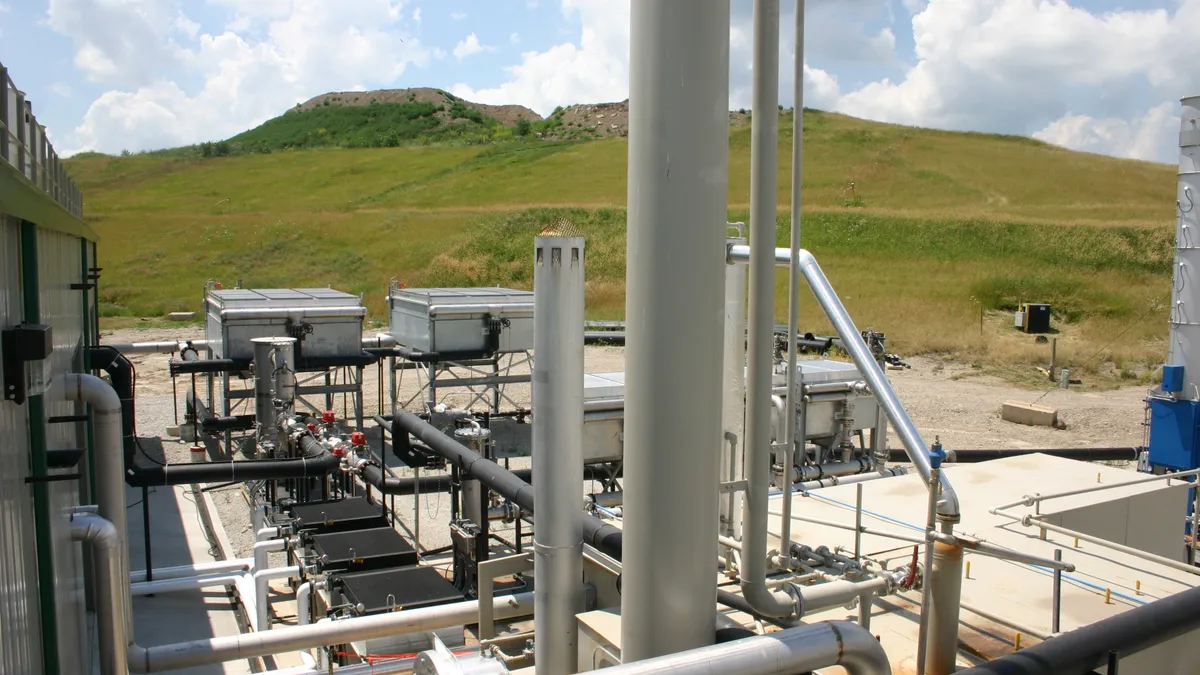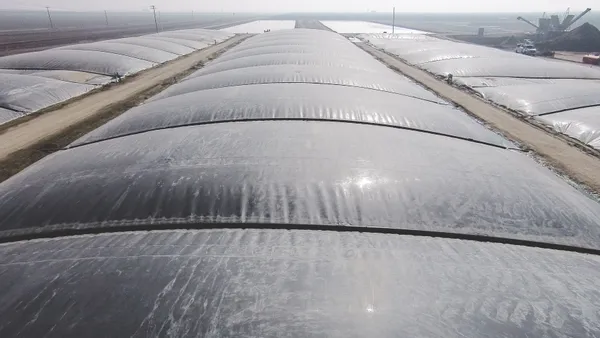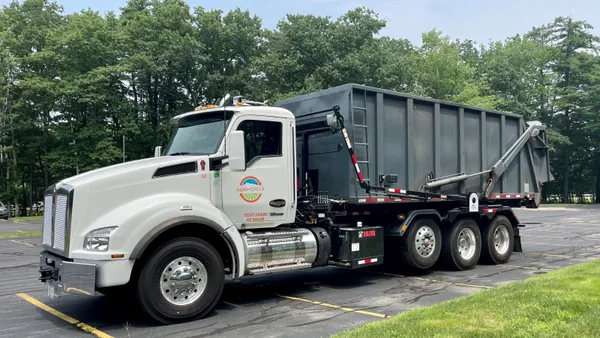Dive Brief:
- The Environmental Integrity Project, a nonprofit that advocates for more stringent environmental regulation, found that competing methodologies could reveal the total emissions from landfills to be anywhere from 5.7 million metric tons of methane to 2.3 million metric tons of methane, according to a report released Thursday.
- EIP is urging the U.S. EPA to update its greenhouse gas reporting methodology to develop consistent and more accurate measurements of methane emissions from landfills. The nonprofit reached a settlement agreement with the EPA in February in which the federal agency agreed to update the model it used to calculate emissions from landfills for the first time since 1998.
- EPA included some of the changes EIP is calling for, including better accounting for landfill covers and methane plumes, in a proposed rulemaking for the Greenhouse Gas Reporting Program it published in the Federal Register on May 5.
Dive Insight:
The EPA has regulated emissions from landfills through various means since the 1990s, but the new report argues emissions accounting models are inconsistent and out of date, resulting in an undercount of landfill methane pollution.
The report’s authors estimated that landfills emitted at least 3.7 million metric tons of methane in 2021, or 295 million metric tons of carbon dioxide equivalent. They argue more widespread adoption of gas collection systems and organics diversion programs would help reduce those emissions, but the methodology updates ensure such policy interventions are working as intended.
The agency has taken a first step toward addressing the issues raised by EIP in the report, circulating a proposed revision of its nearly 15-year-old Greenhouse Gas Reporting Program that would update reporting methodologies for a variety of sectors, including landfills. The rule would factor in periods when a landfill’s gas collection system, cover or flare is not operating as intended for the first time and is slated to go into effect in 2025.
Leah Kelly, a senior attorney with EIP, said the proposal is a good first step, but her organization wants to see additional measures taken to account for and ultimately rein in landfill emissions. Among the recommendations in the report are stronger federal regulations for landfill gas collection systems, a uniform method for estimating emissions from landfills between federal programs and mandatory adoption of direct methane emission measurement.
“They do have regulations on the books, they do have standards on the books. Our view is that they are not good enough,” Kelly said. “That’s really demonstrated by the fact that we’re starting to see more and more states issue standards that are beyond EPA.”
California and Oregon have both passed regulations that would require more landfills to account for emissions than the EPA otherwise requires. California is also looking to further update those standards, Kelly said.
The EPA has required landfills above a certain size to install some measure of gas collection since the 1990s, with limited exceptions. But that still leaves plenty of landfills without such systems — the EPA’s Landfill Methane Outreach Program estimates 609 of 1,381 landfills with sufficient data are subject to gas collection regulations, but the program’s database contains more than 2,600 landfills, according to an EIP analysis of the data.
Because LMOP is a voluntary program to promote landfill gas to energy facilities, the rest of those landfills aren’t required to tell EPA if they appear to be subject to regulation, something the agency has proposed to change and that EIP supports.
“As landfill emissions data from direct measurement studies becomes more widely available, it will be important to assess regulatory drivers affecting the best and worst performers,” the report’s authors wrote. “At present, it is not possible to run this analysis on any meaningful scale.”
The LMOP emissions reporting methodology is also different from the Greenhouse Gas Reporting Program, which was first authorized in fiscal year 2008. Both programs rely on modeling, however, something EIP takes issue with.
In its May 5 proposal, the EPA acknowledged that landfill methane emissions “may be considerably higher” than what was previously reported based on the model in its Greenhouse Gas Reporting Program. The tweaks to the model proposed would “address a potentially large subset of emissions that are currently omitted in reporting” and inform future rulemaking, according to the agency.
EIP is somewhat in alignment with industry groups like the National Waste & Recycling Association, who have also complained that the EPA is behind the times on landfill emissions calculating. Both environmentalists and industry experts point to satellite and drone studies and better real-time monitoring as innovations that have yet to be included in the EPA’s official accounting procedures, but green groups think incorporating those measures would result in higher landfill emissions totals, not less.
“We have different reasons for wanting something similar,” Kelly said. “The methodology assumes consistent operations at landfills, it assumes that systems are working the way that they're designed and working consistently. What [methane] plumes show is that that's not happening.”
The report found that eight out of the 10 landfills it identified as producing the most methane emissions had gas control systems, while two did not. Kelly said those systems are an important piece of reducing emissions, but they should also be paired with additional measures like a good cover and organics diversion to reduce the amount of high-emission materials in the first place.
Kelly said “we definitely know what to do” when it comes to addressing methane emissions, but the EPA needs to pass regulations requiring additional measures in order to make real progress on reducing the sector’s contributions to climate change.
“I don’t know that the problem is necessarily that landfill operators aren’t choosing to implement those requirements. It’s typical of industries that they don’t implement all of the solutions,” Kelly said. “The problem is that it’s not required.”











